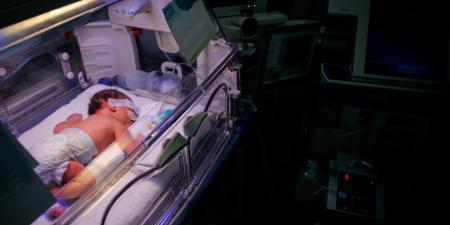Case
An ultrasound performed on a woman who was 23 weeks pregnant revealed multiple findings suspicious for trisomy 21 syndrome, (Down syndrome). The woman and her husband were devastated, saying they could not possibly raise a child with mental retardation and physical anomalies, and they requested a termination. The obstetrician recommended amniocentesis for chromosomal analysis that would give definitive diagnosis of trisomy 21, and the test was performed. The parents said they planned to terminate the pregnancy if the results of the chromosome analysis confirmed Down syndrome.
Before the results were returned, the woman arrived at the labor and delivery unit with a tender abdomen, purulent discharge from the cervix, and high fever. She appeared to have an acute intrauterine infection from the amniocentesis procedure. Antibiotics were started, but it soon became clear that the woman was becoming septic; the obstetrician on call recommended rapid delivery of the fetus. The woman and her husband again clearly stated that they wanted no resuscitation performed on the infant after delivery. The couple and the physicians agreed that, given the probability of a severely anomalous infant, the plan would be to provide only comfort care measures.
The woman's labor was induced and she delivered a liveborn female infant, surprisingly robust. The infant had a strong cry, kicked vigorously, and was much larger than anticipated. The neonatologists examining the infant found themselves reconsidering their decision to withhold resuscitation. Suddenly the seemingly certain prenatal diagnosis of Down syndrome appeared implausible, given the appearance of a strong infant without apparent anomalies. The NICU team realized that, under any other circumstance, resuscitation measures would be well under way; they became uneasy as they watched the premature infant's forceful kicking and energetic cries. Within minutes to hours the female infant's lungs would tire and she would die without respiratory support.
The physicians announced to the parents their decision to reverse their previous plan to withhold care based on the healthy appearance of the neonate. The neonatologist described the resuscitation measures they planned to begin. The parents were infuriated. "We had an agreement," the father retorted. "My wife and I made it very clear to you that we cannot manage an impaired child. This is our decision to make—we're the parents, and it is your duty to respect our wishes."
Commentary 2
This case involves the physician's ethical obligations to a pregnant woman and her husband during pregnancy and also the physician's ethical obligations to a neonatal patient and its parents after liveborn delivery. The difference between these two sets of ethical obligations is crucial for understanding how the team should respond to the refusal of intervention by the child's parents.
The Pregnant Woman as a Patient
The physician's ethical obligations to a pregnant woman are both beneficence-based and autonomy-based. As her fiduciary, i.e., a professional committed to protect and promote her health-related interests, the physician has a beneficence-based obligation to offer, recommend, and perform clinical interventions that are reliably expected to result in the greater balance of clinical goods over clinical harms for the woman in the course of her pregnancy. Pregnant women have their own perspective on health-related and other interests, and the ethical principle of respect for patient autonomy obligates the physician to provide the pregnant woman with the information relevant to her decisions about the clinical management of her pregnancy and then to implement only those clinical interventions that she authorizes as a result of the informed consent process [1].
The Fetus as a Patient
The physician also has beneficence-based obligations to protect and promote the health-related interests of the fetus, but only when the fetus is a patient. The physician does not have autonomy-based obligations to any fetus, because its developmental state does not support the complex psychosocial functioning by virtue of which an individual generates its own moral status. In the language of ethics, the fetus is not capable of generating independent moral status or rights, hence the concept and discourse of fetal rights are best avoided in determining a physician's ethical obligations to a pregnant woman.
The fetus is a patient when it is presented to a physician or other health care professional for clinical interventions. In the language of ethics, the fetus has dependent moral status when there are links between its current existence in utero and its later becoming a child. Before viability (the ability of the fetus to survive ex utero with full technological support) the only link between a fetus and its later becoming a child is the pregnant woman's autonomous decision to confer the dependent moral status of being a patient on her fetus. Prior to viability the pregnant woman is free to withhold conferring moral status or, having conferred it, to withdraw it.
When a woman presents herself to a physician or other health care professional after viability (typically after 24 weeks' completed gestation by reliable ultrasound dating), the fetus is a patient, and the physician has beneficence-based obligations to protect and promote its health-related interests. We emphasize that the fetus is not a separate patient, because these beneficence-based obligations must always be balanced against the physician's autonomy-based and beneficence-based obligations to the pregnant woman [1].
It is well accepted in obstetric ethics that a pregnant woman is free to withdraw the conferred moral status of being a patient from a previable fetus whether the fetus has an anomaly or not. Therefore, a woman is free to continue or end her pregnancy in either case. When there is a suspicion of trisomy 21 with ultrasound late in the second trimester, the obstetrician should attempt to resolve this uncertainty as expeditiously as possible with invasive genetic diagnosis.
In this case scenario, the physician would have been ethically justified to offer the pregnant woman invasive intervention to cause in utero fetal death by intracardiac potassium chloride injection before labor was induced [2]. A major preventive ethics aspect of this case, unmentioned in the scenario, is that this option should have been discussed with the parents by the physician. Because the fetus is previable, the pregnant woman's autonomous decision making determines whether or not it has conferred status as a patient. Had she decided to withdraw the status of being a patient from her fetus at that time, it would no longer have been a patient. Terminating the life of a previable fetus in utero does not violate any professional, beneficence-based obligations to a fetal patient and is therefore permissible in obstetric ethics.
If her pregnancy had continued to viability, then the fetus would have become a patient. We have argued elsewhere that it is permissible to perform an abortion of a viable fetus but only when one of two conditions is met: "a very high probability of a correct diagnosis…[with] either (a) a very high probability of death as an outcome of the anomaly diagnosed or (b) a very high probability of severe irreversible deficit of cognitive developmental capacity as a result of the anomaly diagnosed" [3]. Neither condition, we emphasize, can be competently judged to be met by the presence of Down syndrome, much less the increased risk of Down syndrome. Therefore it would be unethical to perform termination of a viable pregnancy in this context.
The Neonate as a Patient
A fundamental component of the ethical concept of the previable fetus as a patient is that this moral status is a function of the pregnant woman's autonomous decision to confer it. In contrast, infants born alive in the presence of health care professionals become patients independently of the autonomy of their parents. This is because the general ethical concept of being a patient requires only that the human being in question be presented to a physician or other health care professional and that there exist clinical interventions that are reliably expected to result in the greater balance of clinical goods over clinical harms to that human being. Moreover, parents of a liveborn infant become his or her moral fiduciaries, and they, too, are obligated to protect and promote the health-related interests of their child. Thus, a liveborn infant simultaneously acquires two kinds of mutually reinforcing moral status—one as a patient of health care professionals to whom the infant is presented and a second as a child of his or her parents. As their child's fiduciaries, parents have a beneficence-based obligation to authorize clinical intervention when their child's health care professionals have beneficence-based obligations to intervene [4].
Neonatal resuscitation and subsequent neonatal critical care management are understood to be trials of intervention. They are undertaken to achieve the short-term goal of preventing imminent death and the long-term goal of an acceptable clinical outcome. For infants, acceptable outcomes should be understood from a clinical perspective: is continued critical-care intervention reliably expected to preserve some interactive capacity that will support some psychosocial development that is not overwhelmed by the child's condition or the iatrogenic complications of treatment?
The ethical analysis of the neonate's status as a patient has important clinical implications in this case. The outcomes for infants born at reliably estimated 23 weeks' gestation vary according to the infant's sex, its singleton versus multiple status, and administration of steroids [5]. Outcomes also vary by the presence and severity of anomalies [6, 7].
Resuscitation and transfer to the neonatal intensive care unit (NICU) is reliably expected to prevent this neonate's imminent death, hence the short-term goal of clinical intervention, preventing imminent demise, can be reasonably expected to be achieved for this patient.
Concerning the long-term goal of achieving an acceptable clinical outcome, we note that this infant was a singleton and is female, factors that increase her chance of survival and decrease the risk of developmental impairment. In addition, no anomalies have been identified. Even if trisomy 21 had been confirmed by genetic evaluation, that anomaly cannot be reliably predicted to eliminate interactive capacity and psychosocial development; most infants with Down syndrome have mild or moderate mental retardation, both of which are compatible with significant psychosocial development.
The father's express concern that he and his wife are not able to manage an impaired child has uncertain bearing on decision making at this time, because a prediction that their child would be significantly developmentally impaired as a result of extreme prematurity is uncertain. It is ethically impermissible for the team to discontinue clinical management of this neonatal patient at this time, because it cannot be reliably expected that the second goal of critical care intervention—an acceptable clinical outcome—will not be achieved.
The judgment that there is sufficient clinical and ethical justification to resuscitate and transfer the infant to the NICU should be explained to both parents. They should be counseled about continuing clinical management as a trial of intervention that will be reconsidered should evidence-based clinical reasoning subsequently support a prognosis of imminent death that cannot be prevented or of irreversible, profound loss of developmental capacity from the child's condition or iatrogenic complications.
Another preventive ethics aspect of this case is that both parents should be informed prior to birth, that when physicians and other health care professionals have a fiduciary, beneficence-based obligation to continue clinical management, parents have a directly parallel fiduciary responsibility to authorize such management. The goal of the discussion should be to prepare the parents for the shift from obstetric to neonatal ethics and the relatively diminished force of parental autonomy in the latter circumstance. We have argued that these parallel and mutually reinforcing fiduciary obligations are still substantial despite predicted caregiving burdens [1, 3].
References
- Chervenak FA, McCullough LB. Ethics in obstetrics and gynecology. An overview. 1997;75(1):91-94.
-
Fletcher JC, Isada NB, Pryde PG, Johnson MP, Evans MI. Fetal intracardiac potassium chloride injection to avoid the hopeless resuscitation of an abnormal abortus: II. Ethical issues. Obstet Gynecol. 1992;80(2):310-313.
- Chervenak FA, McCullough LB, Campbell S. Third trimester abortion: is compassion enough?. Br J Obstet Gynaecol. 1999;106(4):293-296.
- McCullough LB. Neonatal ethics at the limits of viability. Pediatrics. 2005;116(4):1019-1021.
- Tyson JE, Parikh NA, Langer J, Green C, Higgins RD. National Institute for Child Health and Human Development Neonatal Research Network. Intensive care for extreme prematurity—moving beyond gestational age. N Engl J Med. 2008;358(16):1672-1681.
- Chervenak FA, McCullough LB. The limits of viability. J Perinat Med. 1997;25(5):418-420.
- Chervenak FA, McCullough LB, Levene MI. An ethically justified, clinically comprehensive approach to peri-viability: gynaecological, obstetric, perinatal, and neonatal dimensions. J Obstet Gynaecol. 2007;27(1):3-7.



